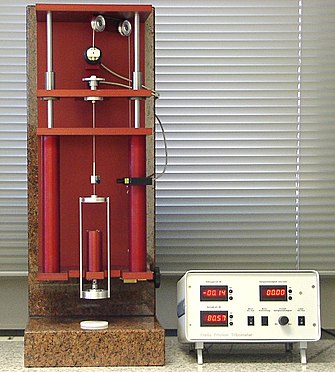| This article needs additional citations for verification. Please help improve this article by adding citations to reliable sources. Unsourced material may be challenged and removed. Find sources: "Tribometer" – news · newspapers · books · scholar · JSTOR (April 2010) (Learn how and when to remove this message) |



A tribometer is an instrument that measures tribological quantities, such as coefficient of friction, friction force, and wear volume, between two surfaces in contact. It was invented by the 18th century Dutch scientist Musschenbroek
A tribotester is the general name given to a machine or device used to perform tests and simulations of wear, friction and lubrication which are the subject of the study of tribology. Often tribotesters are extremely specific in their function and are fabricated by manufacturers who desire to test and analyze the long-term performance of their products. An example is that of orthopedic implant manufacturers who have spent considerable sums of money to develop tribotesters that accurately reproduce the motions and forces that occur in human hip joints so that they can perform accelerated wear tests of their products.
Theory

A simple tribometer is described by a hanging mass and a mass resting on a horizontal surface, connected to each other via a string and pulley. The coefficient of friction, μ, when the system is stationary, is determined by increasing the hanging mass until the moment that the resting mass begins to slide. Then using the general equation for friction force:
Where N, the normal force, is equal to the weight (mass x gravity) of the sitting mass (mT) and F, the loading force, is equal to the weight (mass x gravity) of the hanging mass (mH).
To determine the kinetic coefficient of friction the hanging mass is increased or decreased until the mass system moves at a constant speed.
In both cases, the coefficient of friction is simplified to the ratio of the two masses:
In most test applications using tribometers, wear is measured by comparing the mass or surfaces of test specimens before and after testing. Equipment and methods used to examine the worn surfaces include optical microscopes, scanning electron microscopes, optical interferometry and mechanical roughness testers.
Types
Tribometers are often referred to by the specific contact arrangement they simulate or by the original equipment developer. Several arrangements are:
- Four ball
- Pin on disc
- Ball on disc
- Ring on ring
- Ball on three plates
- Reciprocating pin (usually referred to as SRV or HFRR)
- Block on ring
- Bouncing ball
- Fretting test machine
- Twin disc
Bouncing ball
A bouncing ball tribometer consists of a ball which is impacted at an angle against a surface. During a typical test, a ball is slid on an angle along a track until it impacts a surface and then bounces off of the surface. The friction produced in the contact between the ball and the surface results in a horizontal force on the surface and a rotational force on the ball. Frictional force is determined by finding the rotational speed of the ball using high speed photography or by measuring the force on the horizontal surface. Pressure in the contact is very high due to the large instantaneous force caused by the impact with the ball.
Bouncing ball tribometers have been used to determine the shear characteristics of lubricants under high pressures such as is found in ball bearings or gears.
Pin on disc
A pin on disc tribometer consists of a stationary pin that is normally loaded against a rotating disc. The pin can have any shape to simulate a specific contact, but cylindrical tips are often used to simplify the contact geometry. The coefficient of friction is determined by the ratio of the frictional force to the loading force on the pin.
The pin on disc test has proved useful in providing a simple wear and friction test for low friction coatings such as diamond-like carbon coatings on valve train components in internal combustion engines.
See also
References
- Historic scientific instruments in Denmark
- Hutton, Charles A Mathematical and Philosophical Dictionary Archived 2011-09-26 at the Wayback Machine
- Jones, William R.; Poslowski, Agnieszka K.; Shogrin, Bradley A.; Herrera-Fierro, Pilar; Jansen, Mark J. (1999). "Evaluation of Several Space Lubricants Using a Vacuum Four-Ball Tribometer". Tribology Transactions. 42 (2): 317–323. doi:10.1080/10402009908982223. hdl:2060/19990013975. S2CID 137361318.
- Wei, D.P.; Spikes, H.A.; Korcek, S. (1999). "The Lubricity of Gasoline". Tribology Transactions. 42 (4): 813–823. doi:10.1080/10402009908982288.
- Höglund, Erik (March 1989). "The Relationship Between Lubricant Shear Strength and Chemical Composition of the Base Oil". Wear. 130: 213–224. doi:10.1016/0043-1648(89)90234-2.

